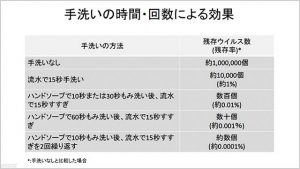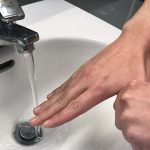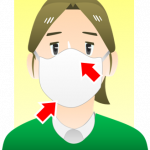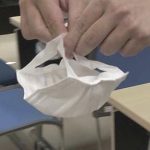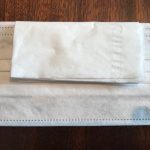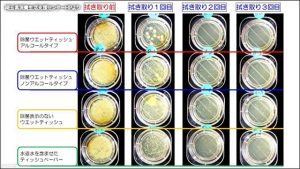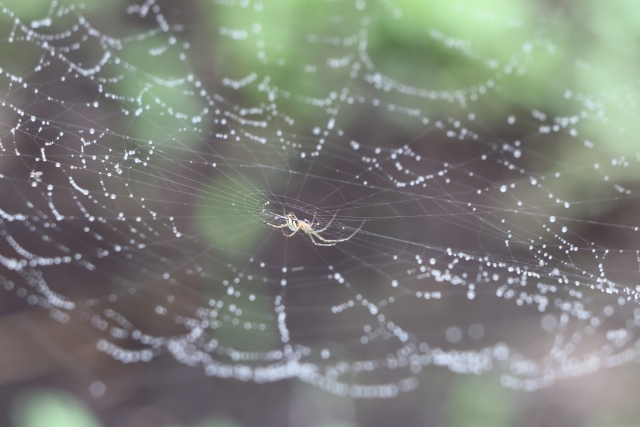How to Protect Yourself from Infectious Diseases
Recently, there were some articles on how to protect yourself from infectious diseases on NHK and other Japanese websites.
They gave good basic knowledge and hygiene on infectious diseases. The tips should work whether it is a common cold, influenza, rubella or the new coronavirus. Here is some information from those sites to help us to minimize the spread of disease and lessen the chances of infection.
Contents
(1) How to protect yourself from infectious diseases: In short
- How we get infected
- Basic protection 1: Avoid overcrowded places
- Basic protection 2: Do not touch your face before washing your hands properly
(2) How to cough and sneeze properly
- Cough into tissue paper
- Cough into your elbow
(3) How to wash your hands to protect yourself from infectious diseases
- How often?
- How long?
- How should we wash our hands?
- How should we dry?
(4) Miscellaneous
- About masks
- How to wear a mask without fogging your glasses
- About sanitizing wet tissue paper
- To prepare your body to fight back against infectious diseases better
- The drawback
- ルビ付き和訳 The Japanese translation
************************************
How to Protect yourself from Infectious Diseases
(1) How to protect yourself from infectious diseases: In short
1. The popular routes of infection
There are some popular routes of infection. One is the splash of liquid containing virus from coughing or sneezing of an infected person. They can spread in the air and you can breathe them in.
Another route is when you inadvertently have touched something with a virus. After that, if you touch your nose or mouth or rub your eyes with those hands, you can get infected.
2. Basic protection 1: Avoid overcrowded places
Stay away from school, office, theaters (we don’t know what to say about hospitals…). Also try not to walk on a very busy street, visit a very busy train station, or take a train, bus or airplane.
3. Basic protection 2: Do not touch your face before washing your hands properly
It is common that when you touch your eyes, nose or mouth with “dirty” hands, you get infected at the membrane of those parts of the body. We will explain the proper way to wash your hands in this post.
(2) How to cough and sneeze properly
1. Cough into tissue paper
Carry some tissue paper with you. Cough, sneeze or spit into a piece of tissue paper, then discard it in a trash can as soon as possible.
Don’t cover your mouth with your palms when you cough or sneeze. You can do so only when you can wash your hands with soap and water immediately afterward.
2. Cough into your elbow
If you don’t have tissue paper or if it’s not ready in time for your coughing or sneezing, use your sleeve. You do it like this poster says:
"Cough Etiquette: Choose one of the following when you cough or sneeze!”
1. Wear a mask
2. Cover with your elbow or
3. Cover with tissue paper or a handkerchief2. means quickly bring your arm in front of you and cough or sneeze in the inside of your elbow.
(3) How to wash your hands to protect yourself from infectious diseases
1. How often?
Washing hands is the most basic and effective way to protect yourself from infectious diseases. Wash your hands as often as necessary. For example, you would like to wash your hands when you come home, get out of a place where a lot of people have gathered, touch a handrail or door knob which a lot of people have touched, and so on.
2. How long?
When we used a bathroom at a supermarket in South Carolina, we saw a very cute sign to teach hygiene to children. It told them to sing “Happy Birthday” twice while washing their hands. It must mean “for about 20 seconds” but it’s more memorable than telling them to count twenty instead.
On NHK, pundits also tell us to wash our hands at least for twenty seconds. However, taking more time may be actually better if we look at the following research results. This was research on the effectiveness of washing hands with different durations by measuring the remaining viruses.
- Before washing hands, there were about one million norovirus.
- After washing hands under running water for 15 seconds, the number of remaining norovirus was reduced to about ten thousand (about 1% of the original number).
- After rubbing hands with soap for 10 to 30 seconds and rinsing under running water for 15 seconds, the remaining virus was several hundred (about 0.01%)
- After rubbing hands with soap for 60 seconds and rinsing under running water for 15 seconds, the remaining virus was several dozen (about 0.001%).
- After rubbing hands with soap for 10 seconds and rinsing under running water for 15 seconds, and repeating the rub and rinse in the same way, the remaining virus was only a few (about 0.0001%).
(By Tokyo Metropolitan Institute of Public Health)
From this, I learned “rubbing hands with soap” is the important part in washing. Before, I would take more time in just rinsing my hands under running water.
3. How should we wash our hands?
First of all, use enough soap. After rubbing all the parts of your hands, including your wrists, you should still see lather on your hands.
Second, rub each finger carefully. As for your thumbs, twist and rub them.
Then rub all the parts between the fingers and the thumbs. Rub your wrists as well.
For your information, in the images below, red areas show the parts which are left unclean most often. The areas in pink are parts frequently left unclean. The left image is the back of the hand, and the right one is the palm side.
Also, we hear that the area around your rings is often left uncleaned.
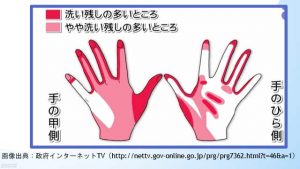
After you finish rubbing, rinse, and always use under running water. Hot or cold doesn’t matter. Washing in a pool of water may allow the viruses go back to your hands.
Lastly, turn the water off without touching the lever.
If soap and water are not available, you may use alcohol or sanitizing gel. In this case, dispense enough liquid or gel in your hands. And quickly rub it in all parts of your hands and wrists making sure no part is left un-rubbed while your hands are still wet.
4. How to dry
Dry your hands with paper towel and discard the towel each time you use it.
Do not share a towel with others. Keep a towel or handkerchief for your sole use.
(4) Miscellaneous
1. About masks
Masks are good to protect you from infectious diseases, but what’s the purpose of wearing them?
A mask protects you from getting the droplets, possibly containing viruses, from coughing or sneezing people right near you. Moreover, it prevents you from spreading the viruses by coughing or sneezing in the open air or onto things.
Therefore, even if masks are not available, you can still attain the same goal by washing your face and hands thoroughly upon returning home, and coughing and sneezing as suggested in this post .
If you use a mask, use a clean, properly packaged one and dispose of it after each use, at least once a day.
Also, when you dispose of a mask, please refer to the photo and the instruction from an NHK article below:
“Pick a used mask up by the loops. Dispose of it in a closed trash can or in a closed polyethylene bag so that people who handle them later will not risk touching the most contaminated center part.”
2. How to wear a mask without fogging your glasses
If you are wearing glasses, you may have experienced fogging of your glasses as you breathe.
Tokyo Metropolitan Police Department offered a solution in their website.
They suggest that you should line the inside of your mask with a folded tissue paper inside to prevent the fogging. I tried it and found it effective, so I can recommend it to you.
There are many “sanitizing” wet tissues on the market. Actually, how effective are they? Here is a test result published by the Saitama Prefecture branch of National Consumer Affairs Center of Japan in January 2018.
They collected some bacteria from a used kitchen sponge and rubbed them onto the table. Then they tested how much bacteria they could remove by wiping the table with four different kinds of tissue paper.
You may say that bacteria and viruses are different and wiping will not disinfect, but we thought the results may interest you.
The top row (marked with red) is the results with antibacterial wet tissue containing alcohol. Far left is the image before wiping, the second from left is after the first wiping, the third after wiping for the second time, and far right is after the third wiping.
The second row (marked with blue) is the results with antibacterial wet tissue without alcohol.
The third row (yellow) is for wet tissue without “antibacterial” treatment and the bottom row (green) is for tissue paper wet with tap water.
We may say the anti-bacterial one with alcohol is the most effective since after the third wiping, we can hardly see any bacteria.
At the same time, it seems that the frequency of the wiping matters most. Please look at the images vertically; none showed a big difference after the first wipe. Also on the far right column, from top to bottom, we can hardly see the bacteria.
4. To prepare your body to fight back against infectious diseases better
As long as we live in a society, we always have a possibility to get infected. Once we get infected, we must rely on our body to fight back, in addition to using vaccinations and medication offered at hospitals.
They say strengthening your immune system and natural healing power are the key. For that purpose, building and maintaining good habits and hygiene help. Some of them are:
- Sleeping regularly
- Eating well
- Keeping yourself clean
- Having good bowel movement
- Having a high metabolism, and
- Enjoying a hobby or something which you know makes you happy
5. The drawback
As I read some articles to write this, I felt very nervous about coughing people around me.
However, I found that it didn’t improve the situation to say (I tried),
“Don’t touch me!” or
“Don’t come near me within one metre!”
“I saw you cough and you were not covering your mouth properly. You are spreading virus.”
…to anyone, family or friend, with whom I would like to get along well with.
For the time being, I will just wash hands well and carry tissue paper with me.
External Links
- 新型肺炎 不安を感じる四つの点「正しく怖がる」ために
- 新型肺炎 知っておきたい「ひじブロック」と「ねじり洗い」
- 除菌とマスク
- やめて!マスクのポイ捨て
- Personal Hygiene
- The New Coronavirus: What we do—and don’t—know
[End of the English post]
感染症を防ぐために
最近、NHKなどの日本のサイトで、感染症の防ぎ方についての記事をいくつか見かけました。
感染症についての基本的な知識と健康管理法が説明されており、アドバイスには普通の風邪からインフルエンザ、風疹、新型コロナウイルスにも共通して有効な部分がありました。
今日はそれらのサイトから、このような病気の拡散を最小限にし、感染をできるだけ抑えるための情報をお伝えします。
目 次
(1)感染症の防ぎ方:まとめ
- 感染はどのように起こるか
- 基本の防御策1:人混みを避ける
- 基本の防御策2:手をちゃんと洗う前は顔を触らない
(2)正しい咳とくしゃみの仕方
- ティッシュの中へ
- ひじで受ける
(3)感染症を予防するための、手洗いの仕方
- 手洗いの頻度
- 手洗いにかける時間
- 手の洗い方
- 手の乾かし方
(4)その他
- マスクについて
- メガネを曇らせないマスクの着け方
- ウエットティッシュによる拭き掃除の効果
- 感染症とたたかう体を作るには
- 問題点
**************************************
(1) 感染症の防ぎ方:まとめ
1.感染はどのように起こるか
感染の仕方のひとつは、感染した人の咳やくしゃみの飛沫によるものです。この飛沫にはウイルスが含まれており、これが空中に飛散すると、他の人が吸い込むことがあります。
また、私たちがウイルスのついたものにさわって、感染することもあります。
2.基本の防御策1:人混みを避ける
学校、会社、劇場などを避けましょう(病院については何と言ってよいかわかりません……)。また、人で混み合った道を歩いたり、混雑した駅へ行ったり、電車、バス、飛行機などに乗らないようにしましょう。
3.基本の防御策2:手をちゃんと洗う前は顔を触らない
「汚れた」手で目、鼻、口などをさわったとき、それらの体の部分の粘膜で感染することがよくあります。正しい手の洗い方を、この投稿でご説明します。
(2) 正しい咳とくしゃみの仕方
1.ティッシュの中へ
ティッシュペーパーを持ち歩きましょう。咳やくしゃみ、痰はティッシュに出して、そのティッシュはできるだけ早くごみ箱に捨てて下さい。
手をすぐに洗えないところでは、咳やくしゃみをするとき口に手のひらを当ててはいけません。
2.ひじで受ける
ティッシュペーパーを持っていなかったり、ティッシュがすぐ出ない場合は、自分の袖を使ってください。やり方はこうです。
[ポスターの画像。英文部をご参照ください]
腕をすばやく前へ持って来て、ひじの内側に向かって咳やくしゃみをし、飛沫を受けます。
(3) 感染症を予防するための、手洗いの仕方
1.手洗いの頻度
手洗いは、感染症から身を守る、最も基本的かつ効果的な方法です。小まめに手を洗ってください。例えば、帰宅したとき、人の多いところから出て来たとき、多くの人がさわった手すりやドアノブにさわったときなどです。
2.手洗いにかける時間
南カロライナ州のスーパーマーケットのお手洗いで、子どものためのかわいい張り紙を見かけました。「ハッピーバースデー」の歌を二回歌いながら手を洗いなさいというのです。20秒ぐらいということだと思いますが、20数えなさいというより覚えやすい。
NHKの記事でも、少なくとも20秒手を洗えといいます。ただ、次の資料を見ると、もっと時間をかけた方がいいかもしれません。これは手洗い時間別のウイルスの残存数を見る研究です。
[研究結果の画像。英文部をご参照ください]
ここから私が学んだのは、「石鹸をつけて手をこすること」が重要だということです。前はよくわからなかったので、流水の中に手を出している時間の方が長かったのです。
3.手の洗い方
まず、十分な量の石鹸を手に取ります。手首も含めて手のすべての部分をこすっても、まだ泡が見えるくらいたくさんです。
[画像]
次に一本一本の指を洗います。親指はねじるようにしてこすります。
[画像]
それから指のあいだも洗ってください。手首もよくこすること。
ご参考まで、下の図で、赤い部分は洗い残しが最もっとも多いところ、ピンクの部分はしばしば洗い残されるところです。左図が手の甲、右が手のひら側です。
[画像]
なお、指輪の周囲にもよく洗い残しがあるそうです。
こすり終わったらすすぎますが、流水ですすぎましょう。水でもお湯でもかまわないのですが、溜め水では、ウイルスが手にまた付いてしまうことがあります。
最後に、レバーにさわらないようにして水を止めます。
石鹸と水がない場合は、アルコールや消毒用ジェルを使うのもいいでしょう。まず十分な量の液体やジェルを手に出します。そして、手が乾かないうちにすばやく、手と手首全体に塗り残しがないようにこすり合わせます。
4.手の乾かし方
ペーパータオルで手を拭いて、使ったペーパータオルはその都度ごみ箱に捨てましょう。
タオルはほかの人と一緒に使わないこと。タオルやハンカチは自分専用のものを使います。
(4) その他
1.マスクについて
マスクは感染症の予防に役立つけれど、マスク着用の目的は何でしょうか。
人がすぐ近くで咳やくしゃみをした時、ウイルスが含まれているかもしれない飛沫を口や鼻に受けないようにすることがひとつ。さらに、自分が咳やくしゃみをしたとき、飛沫を空中に飛散させたり、物に付着させないことです。
ですから、マスクがなくても、外出から帰って顔や手をよく洗うこと、正しく咳やくしゃみをすることによって、同じ目的は達することは可能です。
もしマスクを使うなら、清潔な、きちんと包装されたものを使いましょう。また、使用後は必ず、または少なくとも一日一回は捨てます。
2.メガネを曇らせないマスクの着け方
メガネをかけている人は、マスクをしたら息でメガネが曇ってしまった経験があるかもしれません。
警視庁のホームページに、これについての対策が出ています。
マスクの内側に折りたたんだティッシュを当ててマスクをかけると曇りにくいというのです。実際に試したところ、かなり効果的だったので、お勧めできます。
[画像2点]
3.ウエットティッシュによる拭き掃除の効果
「衛生的」なウエットティッシュがいろいろと売られていますが、効果はあるのでしょうか。
これについて、2018年1月埼玉県消費生活支援センターによる面白い実験結果があります。
この実験では、使用済みの台所用スポンジから採取した細菌をテーブルに付着させました。そして四種類の濡れたティッシュペーパーでテーブルを拭いて、どのくらい細菌を除去できるかを調べました。
細菌とウイルスは別物だし、拭き取りは消毒にはならないとおっしゃるかもしれませんが、ご興味があるかと思います。
[画像]
一番上の列(赤の印)は、アルコールを含む除菌ウエットティッシュです。一番左はテーブルを拭く前の状態、左から二番目は最初に拭いた後、三番目は二回目に拭いた後、一番右は三回目に拭いた後のものです。
二番目の列(青の印)は、ノンアルコールタイプの除菌ウエットティッシュの結果です。
三番目の列(黄色の印)は、除菌表示のないウエットティッシュ、一番下(緑の印)は、水道水を含ませたティッシュペーパーの結果です。
一番効果的なのは、三回目に拭いた後は細菌がほぼ見えないので、アルコール入りの抗菌ウエットティッシュだと言えるかもしれません。
同時に、拭く頻度が大切なようです。左から二番目の画像を縦に見てください。一回拭いただけではどれも大してきれいになっていません。そして、一番右の縦列では、どれにもほとんど細菌が見られません。
4.感染症とたたかう体を作るには
私たちが社会で暮らしている限り、誰でも感染する可能性はあります。感染してしまったら、私たち自身の体にたたかってもらわなければなりません。病院のワクチン接種や薬などの他にですね。
それには、免疫と自然治癒力を高めることがカギだと言われています。このためには、下記のような、心身によい習慣を持って健康衛生を保つとよいそうです。
- 規則的に睡眠を摂る
- 体にいいものを食べる
- 身体を清潔に保つ
- 便通をよくする
- 代謝を上げる
- 気分よくなれるとわかっている趣味などを持つ
5.問題点
これを書くために記事を読んでいて、私は自分の周囲の、咳をしている人々がとても気になりました。
でも、家族でも、友だちでも、仲良くしていきたい相手に
「さわらないで!」
「1メートル以内に近づかないで!」
「さっき咳してたけど、口をティッシュで押さえていなかったね。ウイルスをまき散らしてるよ」
などと言っても(言ってみたのです)、あまり聞いてもらえないようです。
そこで、今のところは、ただ手をよく洗ってティッシュペーパーを持ち歩いています。
外部リンク
- 英文部末尾をご覧ください。
[和文部終わり]

